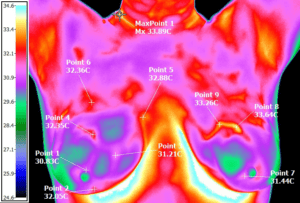 In honor of Breast Cancer Awareness Month, we’ve posted the following article by Debbie Haggerty, RN, Tahoma Clinic’s Certified Thermography Technician.
In honor of Breast Cancer Awareness Month, we’ve posted the following article by Debbie Haggerty, RN, Tahoma Clinic’s Certified Thermography Technician.
BREAST THERMOGRAPHY, WHAT YOU SHOULD KNOW
Do you dread your yearly mammogram? Are you concerned about radiation from multiple mammograms? Have you had a normal mammogram but are still concerned that something is wrong?
Did you know that there is another option for breast cancer screening that is FDA approved, is more sensitive than mammogram and does not involve compression or radiation?
WHAT IS THERMOGRAPHY?
Thermography, or Infrared Mammography, uses a medical grade infrared (heat sensing) camera to take high-resolution images of the heat patterns from your breasts, including the axillary tail of the breast.
HOW DOES THERMOGRAPHY WORK?
Cancer has high metabolic activity that produces more heat than normal tissue. This excess heat can be detected 5 to 8 years before a tumor is large enough to be seen on a regular mammogram which looks for anatomical (structural) changes rather than physiological (functional) changes.
WHAT DOES THE THERMOGRAPHY PROCEDURE INVOLVE?
Prior to your appointment you will be sent a list of preparation instructions and a breast history questionnaire. The procedure takes place in a temperature controlled room (to ensure the test can be repeated accurately). After a 15 minute cooling period a total of six pictures are taken; a first series of three, followed by a ‘cold water’ challenge (where the hands are immersed in cold water for one minute) and a second series of three pictures.
The cold water challenge causes your blood vessels to constrict to hold your body heat in your core. The before and after pictures can be compared to differentiate areas that do not cool evenly (an indication of a problem) versus areas that may appear warm but do cool evenly (an indication of normal temperature variance related to something like a large, surface blood vessel). The cold water challenge, while the most unpleasant part of a thermogram, greatly increases the accuracy of the test results.
WHO READS THE PICTURES?
The pictures and the breast history questionnaire are sent out to be evaluated by a Board Certified thermologist. We then receive a written report that includes the color pictures and a detailed evaluation and grading of your risk of having breast cancer.
WHAT IF MY RESULTS COME BACK ABNORMAL?
Because of the truly early detection thermography can provide, you typically have more time to deal with an abnormal result, unlike an abnormal mammogram where you need follow-up testing, biopsy, surgery, etc. yesterday. While it is still prudent to see your doctor and do follow-up testing in a timely manner, you do not need to panic over an abnormal result. A doctor who is familiar with thermography and natural medicine can advise you regarding any follow-up testing and breast health protocols you should follow. We often see abnormal results return to normal with appropriate early intervention that is NOT invasive.
HOW DO I KNOW IF THERMOGRAPHY IS RIGHT FOR ME?
There are no reasons why you should not have a thermogram, although there are a few instances in which you would be advised to wait to ensure an accurate result. For instance, a thermogram should not be done within three months after breast surgery to allow for full healing and dissipation of any inflammation that would show as heat and cause a false positive result. A full list of what to avoid and for how long prior to imaging is included with the preparation instructions.
Women who may find thermography especially useful include those who:
* Have implants
* Have dense breast tissue
* Are pregnant or lactating
* Are not menopausal
* Are using hormone replacement therapy (HRT or BHRT)
* Have large or small breasts
Tahoma Clinic uses Therma-Scan Reference Laboratory LLC.
For more information or to schedule an appointment for breast thermography, call 206-812-9988.
